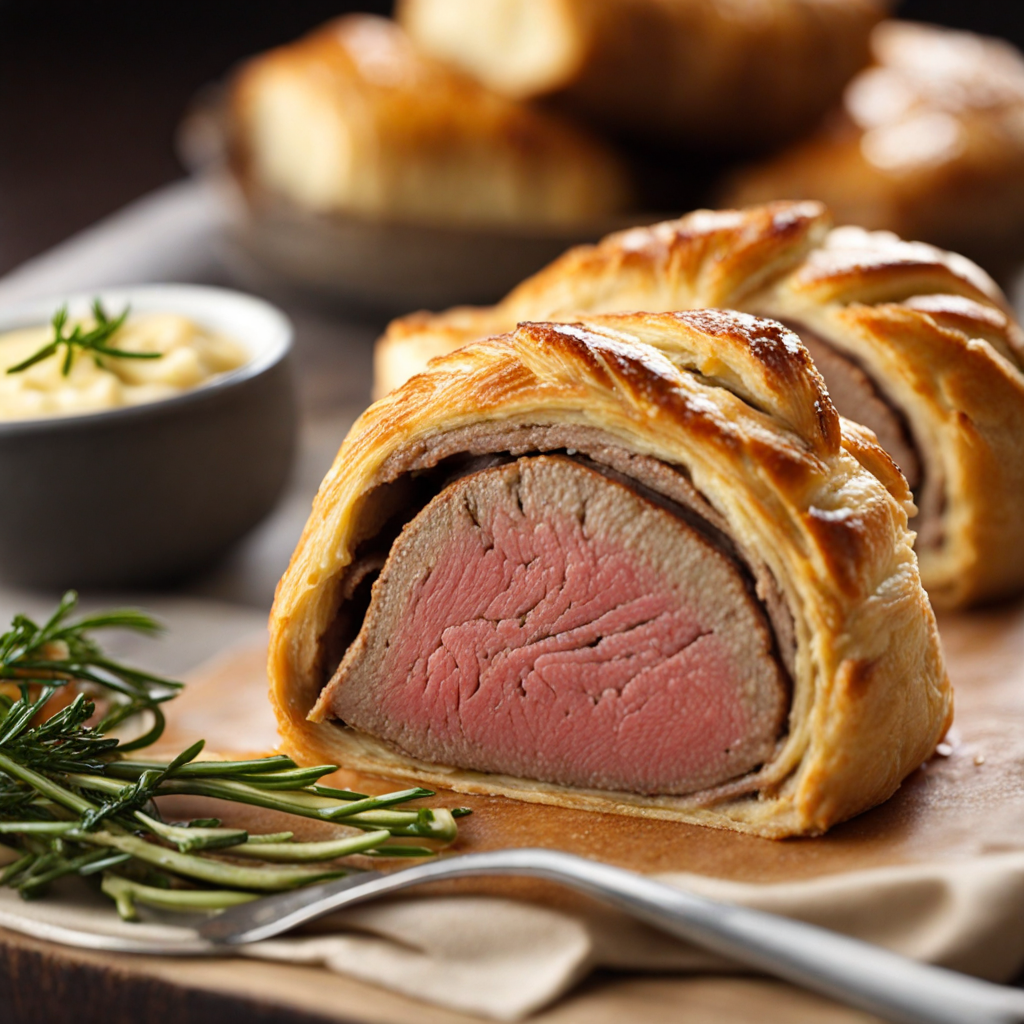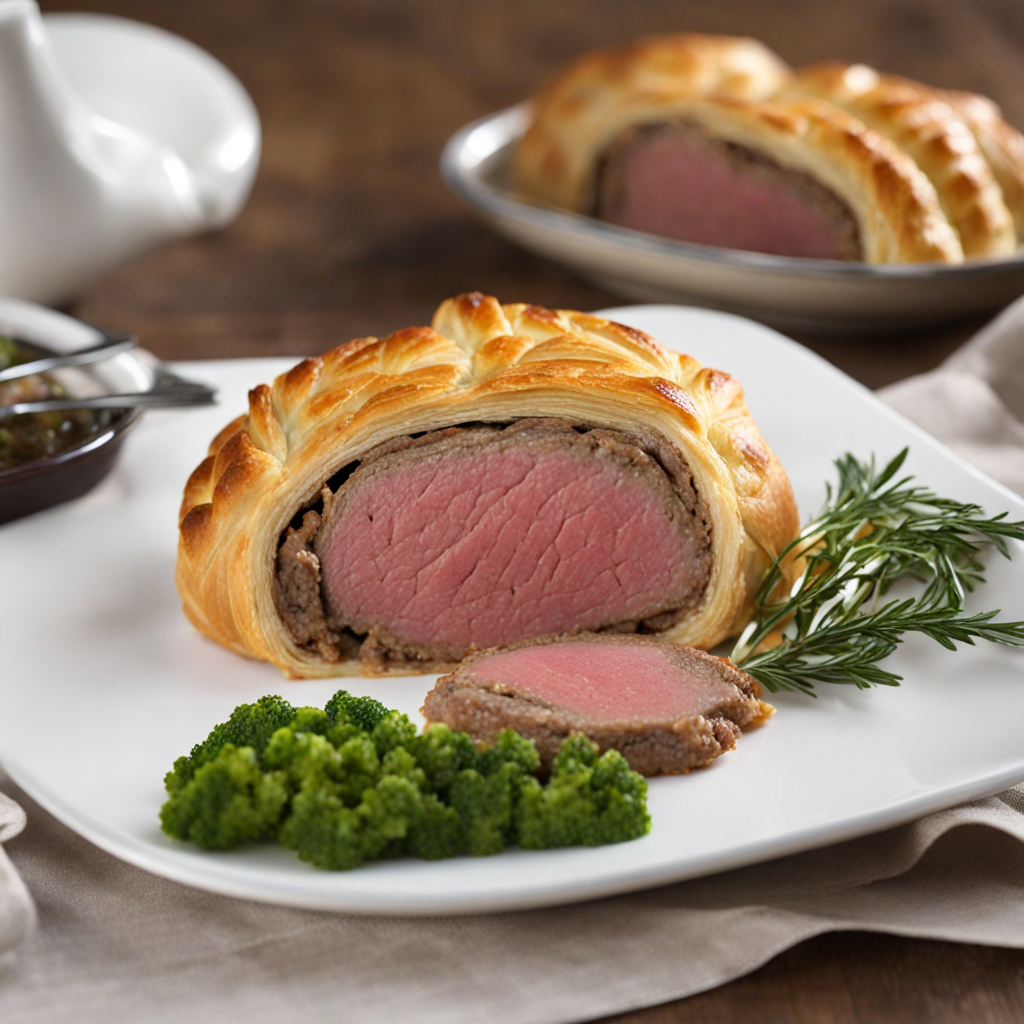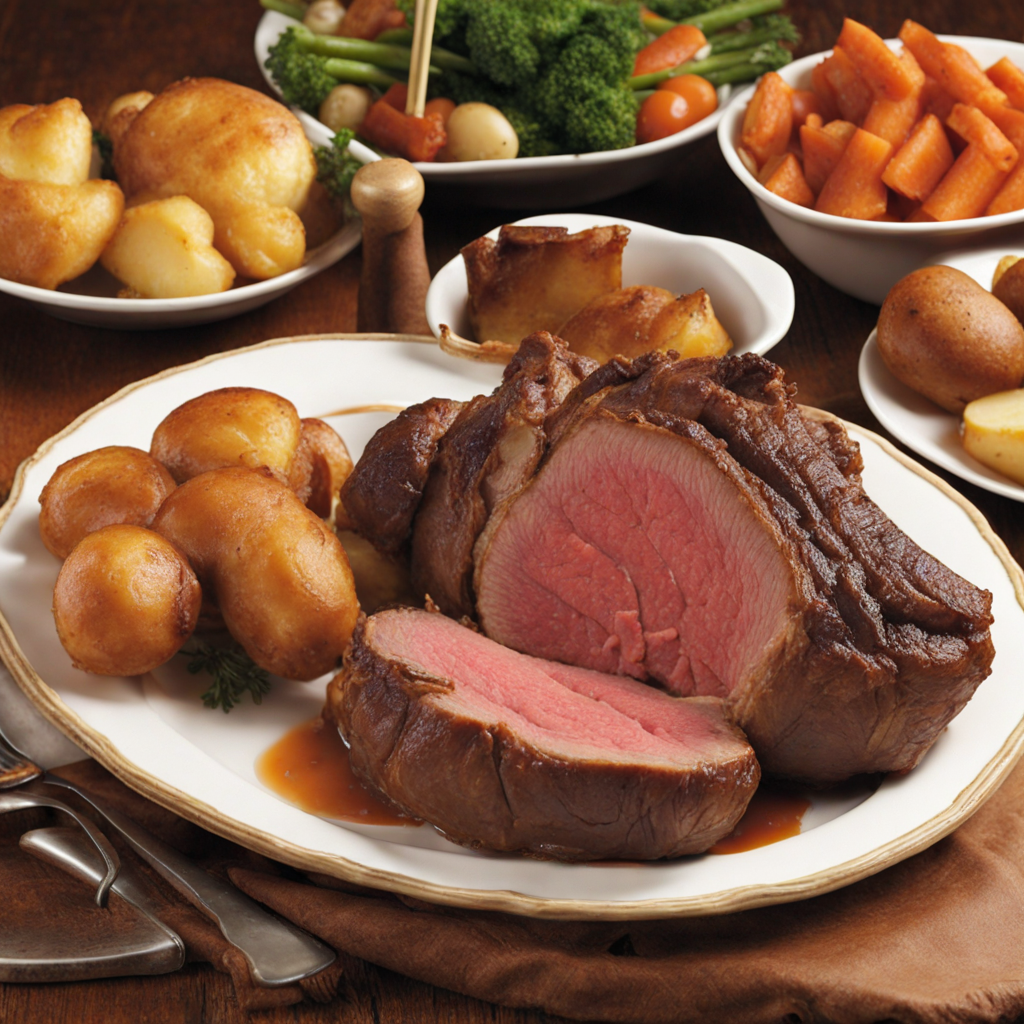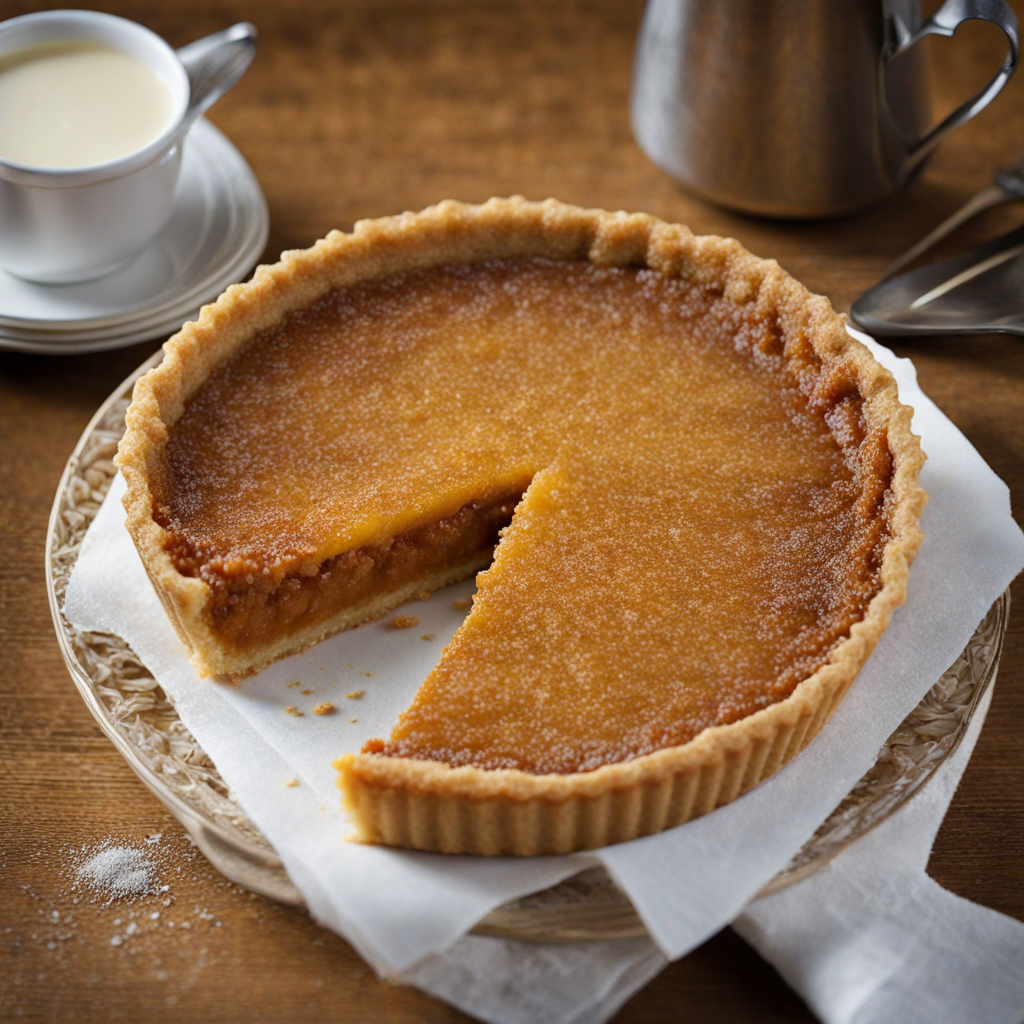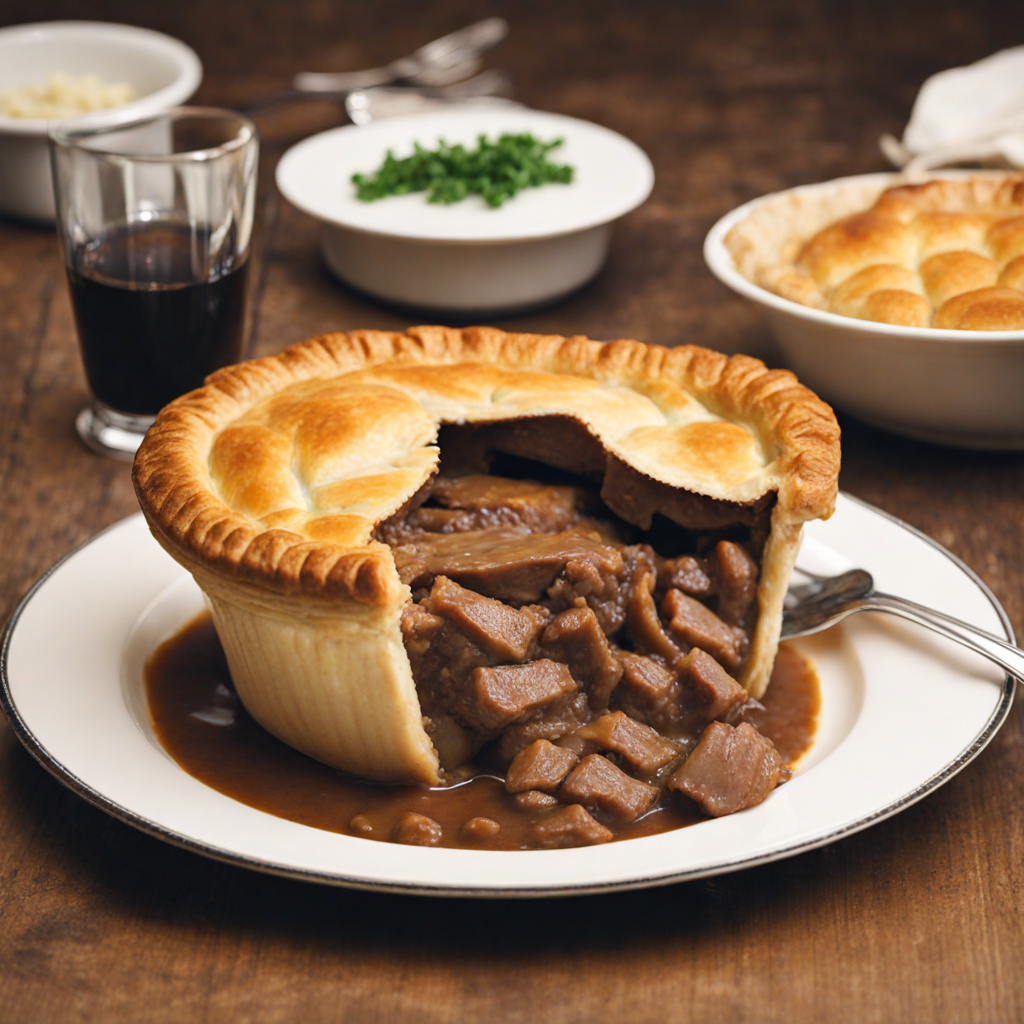Beef Wellington
Beef Wellington is a sumptuous dish that encapsulates the essence of British culinary tradition. At its core, this dish features a tender cut of beef, typically fillet steak, which is seared to perfection. The beef is then generously coated with a flavorful mixture known as duxelles, made from finely chopped mushrooms, shallots, and herbs sautéed in butter. This earthy layer not only enhances the meat's natural flavors but also provides a moist barrier, ensuring that the beef remains succulent during the baking process. Encasing the beef and duxelles is a delicate layer of prosciutto or pâté, which adds a touch of richness and complexity. The entire ensemble is then wrapped in a sheet of puff pastry, creating a golden, flaky exterior that contrasts beautifully with the tender meat inside. As it bakes, the pastry puffs up, enveloping the beef in a buttery, crispy shell that is both visually appealing and deliciously satisfying. The aroma wafting from the oven is an enticing prelude to the feast that awaits. When served, Beef Wellington is often accompanied by classic sides such as roasted vegetables, creamy mashed potatoes, or a rich red wine sauce. The first cut reveals the stunning contrast between the golden pastry and the pink, juicy beef, making it a centerpiece for any special occasion. With its harmonious blend of textures and flavors, Beef Wellington not only delights the palate but also represents a celebration of British gastronomy, making it a must-try for anyone seeking to explore new culinary horizons.
How It Became This Dish
The Culinary Journey of Beef Wellington: A Gastronomic Legend from the United Kingdom Beef Wellington is a dish that has come to symbolize fine dining and British culinary tradition, yet its origins are a tapestry woven with threads of history, culture, and a touch of culinary artistry. This exquisite dish, featuring tender beef fillet coated with mushroom duxelles and wrapped in flaky pastry, has captured the hearts (and appetites) of many, but its journey through time reveals much more than just a sumptuous recipe. Origins of Beef Wellington The precise origins of Beef Wellington remain somewhat nebulous, with several theories attempting to trace its beginnings. One prevailing narrative suggests that the dish is named after Arthur Wellesley, the Duke of Wellington, who famously led the British army to victory at the Battle of Waterloo in 1815. After his triumph, it is said that the dish was created in his honor, celebrating the Duke's return to England as a national hero. The idea that a dish should be named after a person of great stature is not uncommon in British culinary tradition, lending credibility to this theory. However, the concept of encasing meat in pastry is not exclusive to British cuisine. Variations of meat wrapped in dough can be found in many cultures, suggesting that the concept may have predated the Duke. The French “bœuf en croûte,” a dish of beef baked in pastry, shares similarities with Beef Wellington and may have influenced its British counterpart. It’s clear that while the dish may bear the Duke’s name, its culinary roots are more diverse. Cultural Significance Beef Wellington has transcended its origins to become a symbol of festive meals and special occasions in British culture. Its preparation is often associated with celebration, featuring prominently in holiday gatherings, weddings, and dinner parties. The dish embodies a sense of luxury, making it a favorite among chefs and home cooks alike, especially during the festive season when families gather to celebrate and share delicious food. The preparation of Beef Wellington is not merely about the ingredients but also about the ritual of cooking. Crafting the perfect Wellington requires skill, patience, and attention to detail, as the balance of flavors and textures is paramount. The tender beef must be seared to perfection, the duxelles—a finely chopped mixture of mushrooms, shallots, and herbs—must be sautéed until all moisture is evaporated, and the pastry must be rolled out just right to encase the filling without losing its flaky quality. This intricate process fosters a sense of pride and accomplishment among those who undertake it, reinforcing its status as a dish best reserved for special occasions. Development Over Time As the 19th century progressed, Beef Wellington began to appear in cookbooks and dining establishments, establishing itself as a staple of British haute cuisine. The first known recipe can be traced back to the early 20th century when it featured in a number of notable cookbooks. The dish was often served at formal banquets and was a staple on the menus of high-end restaurants, where it was often presented as a centerpiece. During the mid-20th century, the dish experienced a resurgence in popularity, fueled by the growing interest in fine dining and gourmet cooking. This era saw the emergence of celebrity chefs and cooking shows, which helped to popularize classic dishes like Beef Wellington among the masses. Its association with luxury and indulgence made it a desirable dish for home cooks looking to impress their guests. The 1980s and 1990s marked a period of culinary exploration and fusion, leading to various interpretations of Beef Wellington. Chefs began experimenting with different types of meat, such as pork or salmon, and incorporating global flavors into the traditional recipe. Despite these variations, the classic Beef Wellington—made with beef fillet, mushroom duxelles, and puff pastry—remains the gold standard. Modern Interpretations and Popularity In recent years, Beef Wellington has enjoyed a renaissance, thanks in part to reality cooking shows and popular culinary blogs that showcase the dish’s elegance and complexity. Chefs around the world have reimagined Beef Wellington, incorporating diverse flavors and ingredients while maintaining its core essence. For instance, the use of different mushrooms, herbs, and even spices can add a contemporary twist to the traditional preparation, appealing to a modern palate. The dish's intricate preparation has also led to an increased interest in culinary education, with many aspiring chefs seeking to master the art of creating a perfect Wellington. Cooking classes focusing on this dish have gained popularity, as it offers a rewarding challenge that showcases both technical skills and creative expression. Additionally, the rise of social media has played a significant role in Beef Wellington's resurgence. Instagram and TikTok have become platforms for home cooks and chefs to share their culinary creations, leading to a renewed interest in classic dishes. The visual appeal of a beautifully golden-brown, flaky pastry encasing a perfectly cooked beef fillet has made it an ideal candidate for social media sharing, further embedding the dish into contemporary culinary culture. Conclusion Beef Wellington stands as a testament to the rich culinary history of the United Kingdom. Its origins may be shrouded in mystery, but its cultural significance and evolution over time are clear. From its regal associations with the Duke of Wellington to its status as a beloved centerpiece at festive gatherings, this dish has captured the imagination of cooks and diners alike. As we continue to celebrate and evolve our food traditions, Beef Wellington remains a cherished symbol of culinary craftsmanship, embodying the spirit of celebration and the joy of sharing a meal with loved ones. Whether enjoyed in a fine dining restaurant or lovingly prepared at home, Beef Wellington is more than just a dish; it is a delicious link to history, culture, and the art of cooking itself.
You may like
Discover local flavors from United Kingdom


